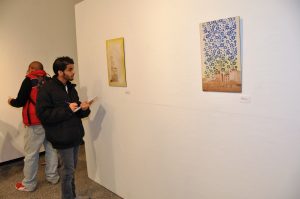
Hannah Jones/Winonan
A terra cotta cocoon gazes at me out of a big-eyed tribal mask, dangling eerily from its mount on the gallery wall. This sculpture, “Growth #13 with Mbunda Face Mask”, possesses a body and a face all its own, a smooth, coiled, living thing that is looking directly at me and actually making me rather nervous.
There is, of course, always something uncannily intelligent about inanimate objects that still have the ability to stare at you.
However, when it comes to sculpture, whether or not a piece actually possesses a face only slightly factors into the strange feeling I get when I face them—the feeling of being watched. Standing in the Watkins gallery with pieces of art on all sides, some with bodies, faces, eyes, and some without, I feel surrounded.
The Watkins gallery, from now to Dec. 5, is popping with these inanimate-animate bodies as it hosts a variety of sculpture artists from Northern Clay Center’s McKnight Foundation.
The Nothern Clay Center, a Minneapolis organization dedicated to teaching and patronizing the art of ceramics and sculpture, gives grants, materials, private studios, and kiln space to its resident artists. The McKnight display highlights some of the Center’s 2011 grant recipients.
The show includes seven distinct artists. A fair few of the displays are surreally dreamlike and a total mystery to my comprehension.
Gerard Justin Ferrari is behind the masked, terra cotta cocoons, silently accusing beings that I almost don’t want to turn my back on for more than two seconds. Naoto Nakada contributes a project involving casts taken from ordinary license plates as well as photos of and questionnaires filled out by the owners of the cars: “What do you like/dislike about your car?” “Do you know the plate number by heart?”
William Cravis’s brightly-glazed stoneware attracts the eye like a magnet. Front and center was his largest piece: a large stoneware bowl about a foot and a half in diameter, its outside covered in earthy-colored spines and its inside a vibrant, intimate pink. The piece is entitled: “(Pitted) Fruit of My Labor”, and indeed, on second glance, the sculpture better resembles an enormous, hollow durian half than anything else. Rina Hongo’s enigmatic porcelain “ZOU Flower”, in spite of its traditionally elegant medium, looks like a spreading spot of char with a sprig of what appears to be PVC piping emerging from the top like a little straw out of a fruity beverage.
Others of the artists contribute works that immediately create a specific meaning when I look at them…
Kevin Snipes has for display several porcelain vases, asymmetrical, lopsided, and covered with colorful, whimsical portraits of unnamed people. “Black Cloud”, a four-sided vase with a dour-looking individual on each side, all under a puffy, charcoal-colored growth at the vase’s spout creates a feeling of universal melancholy. Each individual, although they stand beneath the same cloud, remains isolated on each plane of the vase, unable to connect or acknowledge one another’s grief or depression. Another series of sculptures by Mika Negishi Laidlaw resonates with the viewer on a deep level. Each sculpture in the series resembles a blooming lotus blossom.
The first, “Birth”, is a clean, white bloom just beginning to open, the petals suggestive of the human birthing process and the color indicative of blank slates and new beginnings.
The next sculpture, “Rebirth”, is a lotus with iron-black petals spread wide in a late bloom, revealing a small cluster of shining golden petals at the center. Passing by the two sculptures, my mind’s eye recreates the progression from the white blossom to the black and gold one, mentally watching petals reach up, fan out, darken, shrink, and fall away to reveal the beautiful, gleaming beginning that will spur the cycle once more.
There is a sort of life in sculpture, for even though these pieces are not really sentient or mobile or intelligent, each one carries the emotions, the significances, and the life experiences of both the sculptor and the viewer, making each body a brimming text of feeling, thought, intent, and mystery. The McKnight exhibit succeeds in touching, confusing, challenging, and validating the viewer—an intense experience on all sides.
And let’s face it, those terra cotta figures still creep me out.
Contact Hannah at [email protected]



























































